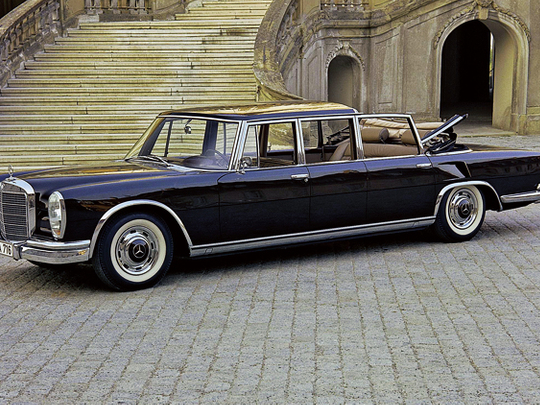
People perceive luxury to be technology. The more gadgets your latest car has, the more luxurious it is. It's true, to an extent, but it needs to be matched by the age-old perception of luxury: materials and craftsmanship.
Which is why a Tiida with a Dh20,000 audio and navigation system isn't a luxury car, but a Merc S-Class is.
A luxury car also needs to innovate and lead the field and, fittingly, Mercedes' S-Class was the first model with ABS disc brakes, pretensioner seat belts, airbags, and a host of other ‘gadgetry'.
In the Sixties though, you couldn't very well rely on circuitry, liquid crystal displays or inflating sacks. Electronics were still a black art, engines were still fed by carburettors, and if you wanted a fancy abbreviation starting with ‘Automatic something something', you needed to apply the fluid science of hydraulics.
Hydraulics helped make the 1963 Mercedes-Benz 600 — it's safe to call it an early S-Class — a groundbreaking car, even if the basic principles of its liquid technology dated back to ancient Greeks and Egyptians.
It was the most luxurious car in the world at the time, when you take all the luxury variables into the equation: it had the technology, it had the company's first V8 engine good for 250bhp from 6.3-litres, it could reach 200kph, it was the size of a totalitarian state, and it weighed as much too — over 2.6 tonnes.
Mercedes also offered limitless options so that each Grosser, or Pullman for the long-wheelbase limousine model, left the factory unique. You could spec a fridge, a minibar, TVs, telephones, armour plating… And if you were a royal, a dictator or the Pope, you probably went for the Landaulet model.
But the big, shouty facet of the 600 was always its maze of hydraulic equipment — which is what weighed the car down to that kerb figure, too — powering the adjustable self-levelling air suspension, the self-closing doors and boot, the automatically adjustable seats and windows, AC vents, central glass divider in the Pullmans, sunroof, and even the suspension dampers. Nothing at the time could come close to claiming such opulence. In fact, it would be an impressive equipment list even today, which is why used Pullmans and Grossers fetch ridiculous money in the classic car market. The smaller Grosser — which funnily enough means ‘big' — will cost you as much as a nice, new S-Class, but the Pullman or Landaulet will command seven figures. If it's a good one, of course. And many aren't…
Thankfully Mercedes built them exceptionally well, using the best-quality steel, while the M100 engine almost never gives up. This unit is also fuel injected, and the transmission can handle its 250bhp and the weight for hundreds of thousands of klicks. The killer is the hydraulics, and the pump can be up to Dh100K to replace. It almost always needs replacing, so make sure that headache went to the last owner. The height control valves (three of them) on the air suspension also frequently die, and that's a 10-grand fix, each.
Find a good one though, and you have an impeccable machine, engineered to be fast, comfortable, and even handle. There's also the added bonus of nothing else on the road ever being able to match the presence of your Grosser.











